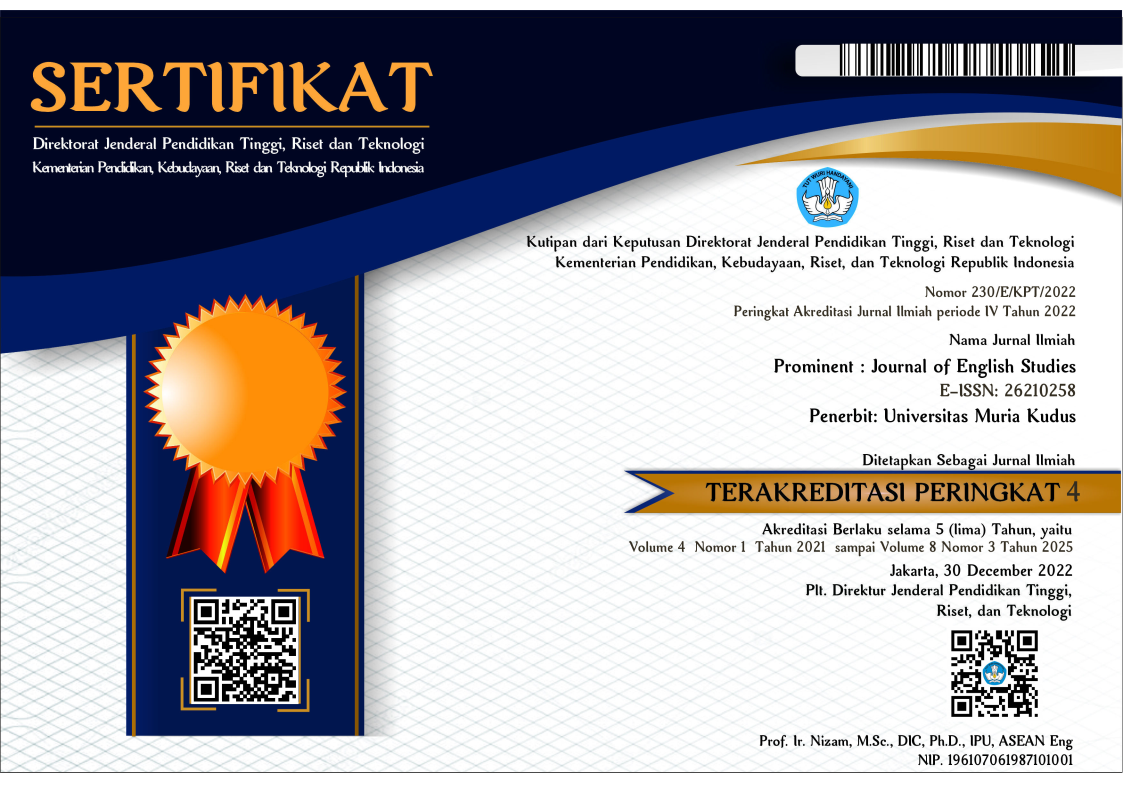READING DESCRIPTIVE TEXT COMPREHENSION IMPROVEMENT BY JOGSAW TEACHING TECHNIQUE
Abstract
The goal of this research was to decide how effective jigsaw improved the comprehension ability of reading descriptive text of class X students of Sultan Agung 1 Semarang Islamic High School in 2018/2019 academic year in understanding descriptive text. This research type was on a quasi-experimental design. The Senior High School students gade tenth as the population of this study which divided into two groups, X IPS 1 class developed as group of class control and X IPS 2 served as the group of experimental. The way to gather some data, Pre-test and post were used to evaluate the students’ competence. Grounded on the results of the study, the mean score of pretest done in the control class was in the average of 52.93, while on the experimental class was happened 53.06. Treatment was implemented on the experiment class in about four times while the control class was educated by conservative teaching. After implementing four times of treatment, the mean score of the post-test of the control class rose up by 60.17. Accordingly, the post-test mean of the experimental class in the average score of 70.32. Based on the results of data analysis showed that there was a significant difference because of the T-test indicating that sig (2-tailed) showed in the number 0.000. Briefly, Ho was rejected but H1 was accepted. This means that jigsaw was operative to enhance reading comprehension ability of the students. Hence, Using jigsaw in understanding descriptive text could give better comprehension in students' reading skills
Keywords: Jigsaw, Reading Comprehension, Descriptive Text
Full Text:
PDFReferences
References
Aebersold, J., & Field, M. (1997). From reader to reading teacher: Issues and strategies for second language classrooms. Cambridge: Cambridge University Press.
Airasian, & Gay, L. G. (2000). Educational research: Competence for analysis an application (6 th ed). New Jersey: Merril Prentice Hall.
Airasian, P. (2000). Educational Research Competencies for Analysis an Aplication (6 th ed). (K. M. Davis, Ed.) New Jersey: Prentice-Hall, Inc.
Anderson, M. a. (1998). Text Types in English 3. Sellanor: Macmilan Education Australia PTY LTD.
Anita Lie. (2008). Cooperative Learning, 55.
Arikunto. (2008). Penelitian Tindakan Kelas. Penelitian Tindakan Kelas.
Arikunto, S. (2006). Prosedur Penelitian: Suatu Pendekatan Praktik. 7th Ed. Jakarta: Rineka Cipta.
Azshar, M. (1993). Proses Belajar Mengajar Pola C.B.S.A. Surabaya: Usaha Nasional.
Best, J. W. (1981). Research in Education. New Jersey : Prentice- Hall, INC.
Bima M, B. and C. K. (2005). Let’s Talk. Bandung:Pakar Raya.
Brown, A., & Palincsar, A. (1984). Reciprocal teaching of comprehension-fostering and comprehension monitoring activities. Cognition and Instruction, 1(2) 117-75.
Creswell, J. W. (1994). Research Design Qualitative and Quantitative Approach. California: Sage Publication, Inc.
Farrel, T. S. C. (2001). Teaching reading strategies: It takes time. Reading in a Foreign Language. 13(2), 631-46.
Hammond, Jenny, et.al. (1992). English for Social Purposes. Sydney: Macquarie University.
Harris. (2007). Standart Reliability.
Harris, D. P. (1969). Testing English as A Second Language. USA: McGraw-Hill, Inc.
Hedge, T. (2008). Teaching and learning in the language classroom. Oxford: Oxford University Press.
Isjoni. (2008). Strength Jigsaw, 57.
Khaki, N. (2014). Improving Reading Comprehension in a Foreign Language: trategic Reader., 14(2), 186–200. https://doi.org/10.1007/978-3-319-56077-9_4
Pardo. (2004). What every teacher needs to know about comprehension, 58(3).
Robinson, P. (2003). Attention and memory during SLA. In C. J. Doughty & M. H. Long, The handbook of second language acquisition (pp. 631-678). United Kingdom: Blackwell Publishing.
Smith, Nile, et al. (1980). Reading Instruction for Today’s Children. New Jersey: Englewood Cliffs. New Jersey: Englewood Cliffs.
Yudhi, N. K., & Fitri, K. (2016). The Effectiveness of jigsaw Learning Strategy to Improve Students’ Reading Ability. Edulite, 1(1), 1–17.
DOI: https://doi.org/10.24176/pro.v3i1.4671
Refbacks
- There are currently no refbacks.
Prominent Journal of English Studies is licensed under a Creative Commons Attribution-ShareAlike 4.0 International License.
Dedicated to:

in Collaboration with APSPBI:






